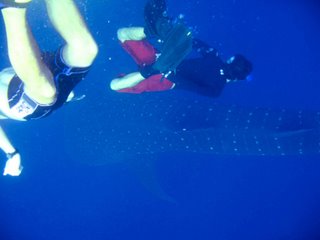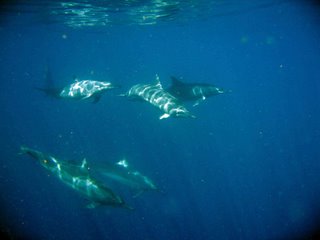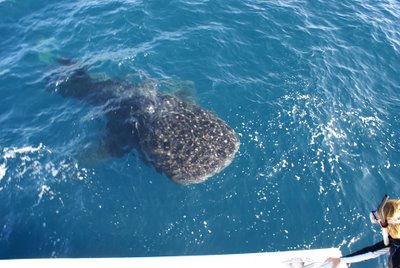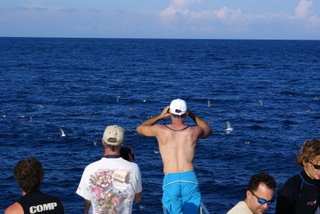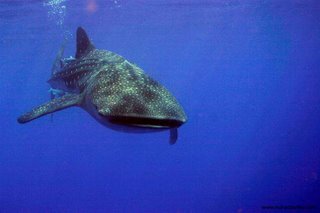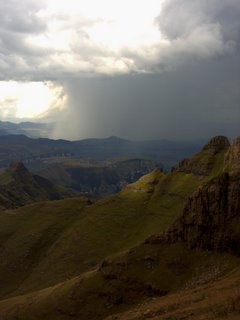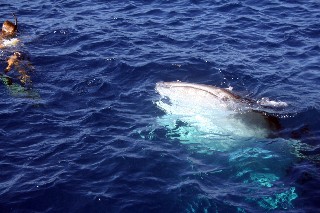Two guests of the Utila Lodge were here in Utila to find whale sharks, and we not put off by the naysayers who told them they were too late to find any. They covered the expenses of the newly retooled Neptune (she's crazy fast now) and Cap'n Lil' Willie and away we went -- on Monday June 16th. We saw nothing, as it turns out. No birds, no dolphins, no turtles, barely any flying fish -- which usually entertain everybody while we're underway looking for the big guys -- It was feeling pretty empty. Our guests were undeterred, however, even turning down an opportunity for some fantastic north side snorkeling in favor of continuing the search for whale sharks.
They came back on Wednesday. We left the dock at our usual 1:15 departure time, setting out southeast of Utila. After not seeing anything, we headed north. And we kept going -- there was a massive container ship out about four mile north east of the island, and we figured to go check it out. Massive! Looking in the wake of the ship, I was certain I saw something though I wasn't sure what. Then I saw it again: Dolphins! They heard our engine and came on over for some bow riding and wake surfing off the Neptune. We counted 9 spinner dolphins (Stenella longirostris) including two calves. They played with the boat, and we even go in the water for a moment, but, typical of spinners, they lost interest in us once the engine started, and took off.
Feeling better about the abundance of life in the sea, we head out west along the north side of Utila, still crowing about the dolphins. A little bit more life, flying fish and all, but no boils. Eventually we were out past Sandy Key at 4 pm thinking that it was time to pack it in and wait till Friday, in fact, Lil' Willie was turning back to head round the north side for one more pass on the way back, when he pulled Neptune hard around almost 180 degrees, gunning her engine and yelling "birds!"
There was a flock of at least 40 terns flying around a boil, with 10 boobies flying and sitting in the water, and a handful of frigates circling overhead. Lil' Willie points out the big shadow beneath the boil THE WHALE SHARK! There was also another boil a few hundred meters off. Soon we were arranged on the transom of Neptune waiting for Willie to give us the go ahead to get in... "GO!"
And there he was, a smallish juvenile male; a little shy, but we didn't scare him, we kept very still and watched as he ate. Ritsert, my research assistant and I were able to get a couple of good looks at the shark’s pelvic region, and I go some left-side id shots to send in to the ecocean database. It wasn't a very long encounter, maybe 2 minutes, and when the shark dove, we swam back to the boat.
It turns out that while Ritsert and I had gotten some nice view of the shark, our guests only barely saw him. Sometimes, even when you're diving with a giant fish it takes practice to see him. Also, jumping off the back of a moving boat, and swimming through the white bubbles of the jet wash (Neptune is a jet drive boat -- no spinning propeller blades) it can be hard to know where to look. I must admit, my 3 foot long freediving fins help quite a bit for catching up with the sharks, though, so I often get a chance to see the animals before the guests do.
We got another opportunity to get in with this shark about 10 minutes later. It was really easy to get everyone into and out of the water, since there were only 4 of us. This time the animal was about 10 meters from the boat, but turned around and swam towards us after we got in. He checked us out while I took pictures, and this time everyone saw him, but after taking a look, the shark decided it was time to go and swam under us on the way down to the depths.
Back in the boat with big smiles all around, we agreed with Lil' Willie to go look at the other boil, which was now about a quater mile away. Once there, we quickly saw a shark -- the shadow, the tailfin, and we slipped into the water, with a slightly smaller shark than the first one we saw -- just coming down out from a vertical feeding position. This guy was cute and curious -- swimming around us with his mouth open, feeding and obviously not afraid as we hung out fro about 7 minutes -- with my camera stuck on continuous shot, I got a about 100 pictures, plenty of id shots for ecocean, too.
After that we were just stoked, and could have gone home content, but Willie prevailed upon us to try one more time, and it's hard to say no to swimming with a whale shark, especially one as friendly as this one. Plus, I had noticed a scar on this guy's tail, which I wanted to photograph -- I didn't know if I had gotten any good tail shots on the last jump. So we did. This time the shark probably circled us about 4 times, giving us inquisitive looks and sniffs while passing by feeding. There were fish everywhere! He was being followed by a school of blackfin tuna, and had little blue fish streaming by his mouth in rivers. It was fantastic. And we barely had to swim anywhere, as he kept coming back. Eventually I had all the photos I needed and was able o just relax and witness. This encounter lasted about 10 minutes.
When we returned to land, we rushed back to the WSORC office to look at the photos, and it was apparent even to the naked eye that the spot patterns on the two sharks were distinct -- Two different sharks! In the middle of June! It was fantastic. I crowed about it, well, not too much, all evening.
And people talk -- I heard that the next morning there were 5 or six dive boats out by Raggedy Cay, swimming with a whale shark. We planned to go out that afternoon, though unfortunately our guests for the afternoon never showed, thus preventing us from covering the costs of captain and fuel. Still, we felt somewhat reassured that that we saw the sharks the day before, and had the opportunity to id them and report them to ecocean, although there were also reports of an oceanic whitetip shark (Carcharhinus longimanus) swimming in the boil as well -- and I would LOVE to swim with one of them.
Interestingly enough, the following week, when we heard back from ecocean about the sharks we reported, not only did they confirm the two we saw on June 18th as two distinct and previously unidentified sharks, neither one of them was the shark reported on June 19th -- who had been previously spotted in Belize a month prior.
Fascinating animals, and so much we still don't know about what they're doing. Once thing we do know, though, is that they surprise and inspire us every time, and that they have been seen every month this year, so far. Just waiting for July's...
--Bryan Becker, Director of Research, WSORC, the Whale Shark and Oceanic Research Center,
Utila, Bay Islands, Honduras








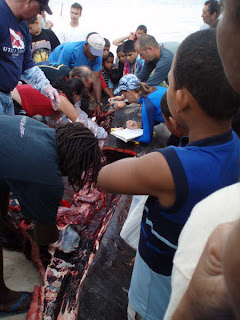


















 One individual was particularly inquisitive and spent a long while within arms reach of the snorkelers. Credit to the group, no one actually touched the dolphins but the experience was incredible.
One individual was particularly inquisitive and spent a long while within arms reach of the snorkelers. Credit to the group, no one actually touched the dolphins but the experience was incredible. 


